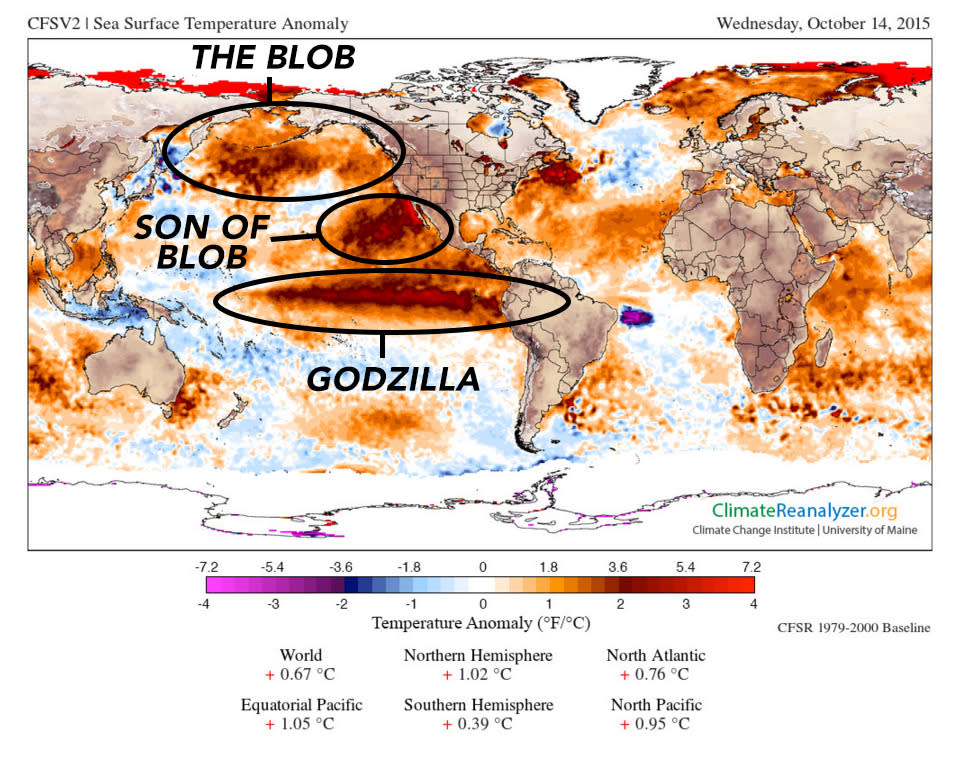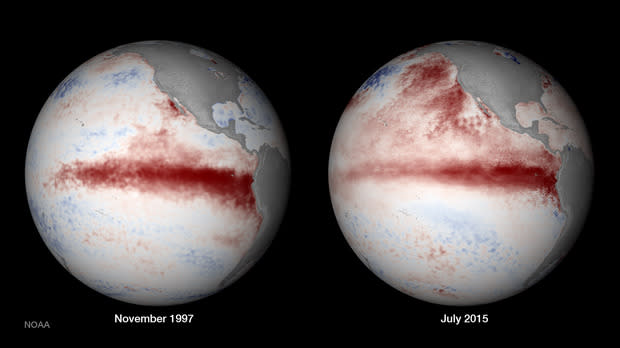Move Over, El Niño. There’s a Crazy New Weather Threat Here.

Areas of above-average sea temperatures dominating the Pacific Ocean have been dubbed “the Blob,” “Son of Blob,” and “Godzilla.” (Modified image: ClimateReanalyzer.org)
By now, everyone has probably heard about El Niño and the effects of this weather pattern across the Western Hemisphere. Some are predicting this El Niño to be the biggest ever, naming it the “Godzilla El Niño.” But step aside, Godzilla: Another monster weather anomaly has been wreaking havoc with the West Coast. Beware of “the Blob.”
First identified (and nicknamed) in 2014 by Nick Bond, a climatologist at the University of Washington, the Blob is a huge mass of warmed ocean waters (about 5 degrees Fahrenheit above normal) lurking in the Pacific Ocean just off the western coast of North America, now stretching its reach from Mexico up to Alaska. The 60-foot-deep blob of water is causing great problems with weather and wildlife and continues to require health advisories for visitors and locals alike.
And as the El Niño weather system has been storming across the Pacific this season, it has stirred up ocean waters enough to cool down the original Blob off Alaska but at the same time helped give birth to what has been nicknamed the “Son of Blob” off the coast of Southern California. The still-warmer Alaskan waters and Son of Blob sector are expected to continue to magnify the El Niño effect for months to come, according to Weather Underground’s “Blob Watch” blog.

This satellite image from October 2015 shows weather patterns affecting climate change. (Photo: NOAA)
For travelers, these unexplained blobs can affect what you see (for whale watching and other nature viewing), your fishing (people fishing have caught odd species in odd spots), and what you can eat (a resulting toxic algae bloom has prompted warnings in certain areas against eating shellfish and other species).
And whatever the cause, from global warming to the “Pacific Decadal Oscillation” or a “Ridiculously Resilient Ridge,” the fact is, the waters are warmer. The first effect has been warming temperatures in the Pacific Northwest. NOAA satellite imagery shows the dramatic combination of the two systems. One researcher in Alberta, Canada, has gone so far as to say “this may be the year that winter is canceled.” So if you’re planning to go skiing or ice fishing in western Canada this winter, bring some hiking and biking gear as well.
Related: 9 Ways El Nino Might Ruin Your Winter Vacation
Visitors to the Northern California shores in 2014 were shocked to see masses of beached starving, dying sea lions, thought to be a result of lack of fish in the waters (their normal meals migrated to cooler waters). Sausalito’s Marine Mammal Center reported having to rescue more than 1,100 of the sea lions that season. Then in 2015, dozens of disoriented seal and sea lions began wandering inland, including poor Rubbish the sea lion pup, who had to be rescued from the streets of San Francisco and brought to the center for treatment. Considered the result of a neurotoxin from red algae growing in the warm waters, this algal bloom is now killing off seals. The Marine Mammal Center is treating some seals with a healthy fish diet and liquids, but the troubles continue. Travelers to Northern California beaches should be aware of potentially sick or strangely acting sea lions and contact the MMC if they find one.

This image from NOAA shows sea surface temperature anomalies from November 1997 and July 2015; the 2015 image also shows the Blob, a large pool of warm water along the northwestern coast of the U.S. (Photo: NOAA)
Most alarmingly for travelers and locals alike is the danger the Blob-influenced algae blooms have on human-consumed seafood. In the fall, the California Department of Health lifted a ban on harvesting mussels but maintained a warning against eating anchovy, sardines, and crabs from Monterey, Santa Cruz, and Santa Barbara counties because of high levels of the potentially fatal domoic acids. So if you’re traveling to the area, make sure to check where your seafood has come from — and don’t go grabbing any of these yourself.
Related: Forget El Niño — These East Coast Ski Resorts Are Great at Snowmaking
Seafood bans have also had an impact on certain parts of Oregon and Washington as well with at least one commercial fishery closed for the season. A 2009 study by NOAA shows that the influence of an extended “red tide” season like that of the Blob could result in a more than $22 million loss in tourist revenues to the Washington coast, where razor-clam digging is a popular tourist activity.

How El Niño works. (Photo: Thinkstock)
The whale-watching season is also being affected by the Blob. Certain species of whales, like humpbacks, which have a diet similar to sea lions, may also be suffering the effects of the poison algae. Record whale beachings and die-offs have been seen from Chile up to Alaska, and while the root cause is unknown, the Blob is a prime suspect. The numbers of observed dead whales don’t appear to be large enough to affect the species, and as naturalist Jackie Hildering told Yahoo Travel, “there is not likely [yet] to be an impact” on numbers seen in whale watching, but the warm waters are shifting migration patterns and could result in “exotic species coming into areas where previously they were not.”
This could be a boon to whale-watching and fishing expeditions in the Pacific Northwest looking to find something new, like tropical sunfish and thresher sharks off of Alaska.
But still, beware of the Blob: On a recent whale-watching expedition of my own to British Columbia, my ship was delayed due to extreme weather in part caused by the unnaturally warm waters, the captain citing the Blob as a factor. And the rogue wave that has been blamed for the tragic sinking of another whale-watching boat may also have been a result of the strange happenings of the Blob — travelers should keep tuned in to National Weather Service alerts and be prepared for a very unusual winter indeed.
WATCH: Where to Spot the Northern Lights in the U.S. Before They Dim
Let Yahoo Travel inspire you every day. Hang out with us on Facebook, Twitter, Instagram, and Pinterest. Check out our original adventure travel series “A Broad Abroad.”


